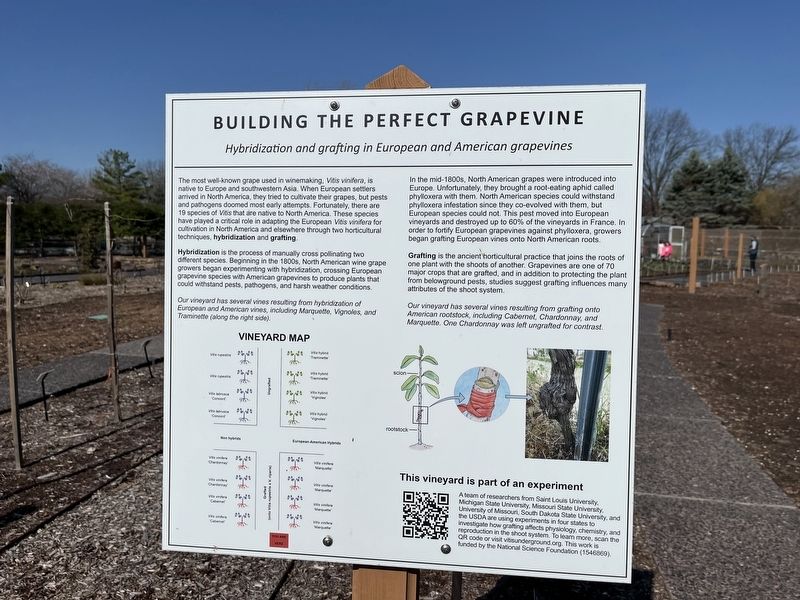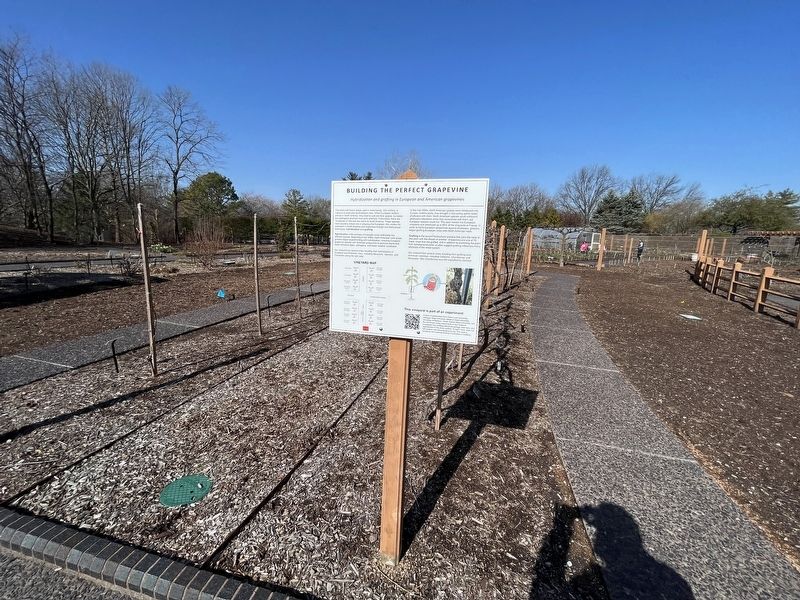Missouri Botanical Garden in St. Louis, Missouri — The American Midwest (Upper Plains)
Building the Perfect Grapevine
Hybridization and grafting in European and American grapevines
The most well-known grape used in winemaking. Vitis vinifera, is native to Europe and southwestern Asia. When European settlers arrived in North America, they tried to cultivate their grapes, but pests and pathogens doomed most early attempts. Fortunately, there are 19 species of Vitis that are native to North America. These species have played a critical role in adapting the European Vitis vinifera for cultivation in North America and elsewhere through two horticultural techniques, hybridization and grafting.
Hybridization is the process of manually cross pollinating two different species. Beginning in the 1800s, North American wine grape growers experimenting with hybridization, crossing European grapevine species with American grapevines to produce plants that could withstand pests, pathogens and harsh weather conditions.
Our vineyard has several vines resulting from hybridization of European and American vines, including Marquette, Vignoles, and Traminette (along the right side).
In the mid-1800s, North American grapes were introduced into Europe. Unfortunately, they brought a root-eating aphid called phylloxera with them. North American species could withstand phylloxera infestation since they co-evolved with them, but European species could not. The pest moved into European vineyards and destroyed up to 60% of vineyards in France. In order to fortify European grapevines against phylloxera, growers began grafting European vines onto North American roots.
Grafting is the ancient horticultural practice that joins the roots of one plant with the shoots of another. Grapevines are one of 70 major crops that are grafted, and in addition to protecting the plant from belowground pests, studies suggest grafting influences many attributes of the shoot system.
Our vineyard has several vines resulting from grafting onto American rootstock, including Cabernet, Chardonnay, and Marquette. One Chardonnay was left ungrafted for contrast.
This vineyard is part of an experiment
A team of researchers from Saint Louis University, Michigan State University, Missouri State University, University of Missouri, South Dakota State University, and the USDA are using experiments in four states to investigate how grafting affects physiology, chemistry, and reproduction in the shoot system. To learn more, scan the QR code or visit vitisunderground.org. This work is funded by the National Science Foundation (1546869).
Erected by Missouri Botanical Garden.
Topics. This historical marker is listed in these topic lists: Animals
Location. 38° 36.762′ N, 90° 15.658′ W. Marker is in St. Louis, Missouri. It is in Missouri Botanical Garden. Marker can be reached from Shaw Boulevard west of Tower Grove Avenue, on the left when traveling west. Touch for map. Marker is at or near this postal address: 4344 Shaw Boulevard, Saint Louis MO 63110, United States of America. Touch for directions.
Other nearby markers. At least 8 other markers are within walking distance of this marker. Rethinking Our Trial Beds (a few steps from this marker); Catching the Wind (within shouting distance of this marker); Chinese Garden (within shouting distance of this marker); Kresko Family Victorian Garden (about 300 feet away, measured in a direct line); William T. Kemper Center for Home Gardening (about 300 feet away); Bronze Garden Sculpture (about 300 feet away); The Gardens of Henry Shaw (about 600 feet away); Going West (about 600 feet away). Touch for a list and map of all markers in St. Louis.
Credits. This page was last revised on July 18, 2023. It was originally submitted on April 2, 2023, by Devry Becker Jones of Washington, District of Columbia. This page has been viewed 49 times since then and 4 times this year. Photos: 1, 2. submitted on April 2, 2023, by Devry Becker Jones of Washington, District of Columbia.

